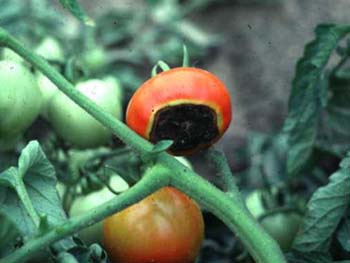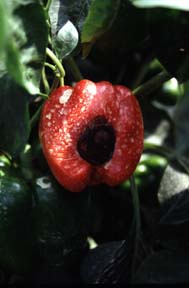|
|










Tomato shown with blossom end rot
Pepper shown with
blossom end rot
Failure of Fruit to Set
When tomatoes bloom but fail to set any fruit it is usually due to one of several factors. These include: lack of pollination, too much nitrogen fertilizer, night temperatures either under 50 degrees or over 70 degrees, daytime temperatures over 85 degrees, extended periods of cloudy weather, irregular watering, insects such as thrips or a poor choice of varieties. While any of these factors can affect the amount of fruit set, combinations of them can be the cause of crop failure. If nothing else seems to make sense, try hand pollinating the blooms by tickling them with a soft bristled brush.
When tomatoes bloom but fail to set any fruit it is usually due to one of several factors. These include: lack of pollination, too much nitrogen fertilizer, night temperatures either under 50 degrees or over 70 degrees, daytime temperatures over 85 degrees, extended periods of cloudy weather, irregular watering, insects such as thrips or a poor choice of varieties. While any of these factors can affect the amount of fruit set, combinations of them can be the cause of crop failure. If nothing else seems to make sense, try hand pollinating the blooms by tickling them with a soft bristled brush.
Welcome to Lou's Greenhouse
Problem: What causes a big black spot on the blossom-end of my
tomatoes or peppers
Answer: The problem is called Blossom-End Rot and is caused by a lack of calcium within the fruit. When calcium reaches low levels in the tomato, the fruit simply dies back at the bottom leaving the characteristic black or brown spot. Calcium is present in most soils in adequate amounts. The problem is that the plant cannot absorb enough calcium through its roots because of dry soil conditions. That's because calcium is taken up by the roots along with water. If, for some reason, water uptake is restricted, calcium uptake will stop.
What can you do about it? Have your soil tested to make sure you have enough calcium in the soil. If you don't, add either limestone (if the soil's acidity level or pH is below 6.0) or gypsum. If calcium levels are adequate, the most important control measure is to maintain optimum soil moisture. Whenever tomato plants are allowed to experience the slightest bit of water stress, you are causing black spots on your fruit. To maintain good soil moisture, try using a mulch of straw, leaves, or even grass clippings to prevent evaporation.
Tomatoes need about one inch of water per week as a minimum. If you do not get this through rainfall, you will need to apply the water. As a rough estimate, each tomato plant needs approximately 3-5 gallons of water each week. If you use a mulch, this amount may be cut in half. When watering, don't lightly sprinkle the ground. Apply the water so it enters the ground and moves through the soil to a depth of 8-12 inches. Shallow watering only encourages shallow rooting which leaves tomato plants more prone to wilting.
Blossom-end rot is a serious disorder of tomato, pepper, and eggplant. Growers often are distressed to notice that a dry sunken decay has developed on the blossom end (opposite the stem) of many fruit, especially the first fruit of the season
Answer: The problem is called Blossom-End Rot and is caused by a lack of calcium within the fruit. When calcium reaches low levels in the tomato, the fruit simply dies back at the bottom leaving the characteristic black or brown spot. Calcium is present in most soils in adequate amounts. The problem is that the plant cannot absorb enough calcium through its roots because of dry soil conditions. That's because calcium is taken up by the roots along with water. If, for some reason, water uptake is restricted, calcium uptake will stop.
What can you do about it? Have your soil tested to make sure you have enough calcium in the soil. If you don't, add either limestone (if the soil's acidity level or pH is below 6.0) or gypsum. If calcium levels are adequate, the most important control measure is to maintain optimum soil moisture. Whenever tomato plants are allowed to experience the slightest bit of water stress, you are causing black spots on your fruit. To maintain good soil moisture, try using a mulch of straw, leaves, or even grass clippings to prevent evaporation.
Tomatoes need about one inch of water per week as a minimum. If you do not get this through rainfall, you will need to apply the water. As a rough estimate, each tomato plant needs approximately 3-5 gallons of water each week. If you use a mulch, this amount may be cut in half. When watering, don't lightly sprinkle the ground. Apply the water so it enters the ground and moves through the soil to a depth of 8-12 inches. Shallow watering only encourages shallow rooting which leaves tomato plants more prone to wilting.
Blossom-end rot is a serious disorder of tomato, pepper, and eggplant. Growers often are distressed to notice that a dry sunken decay has developed on the blossom end (opposite the stem) of many fruit, especially the first fruit of the season


















